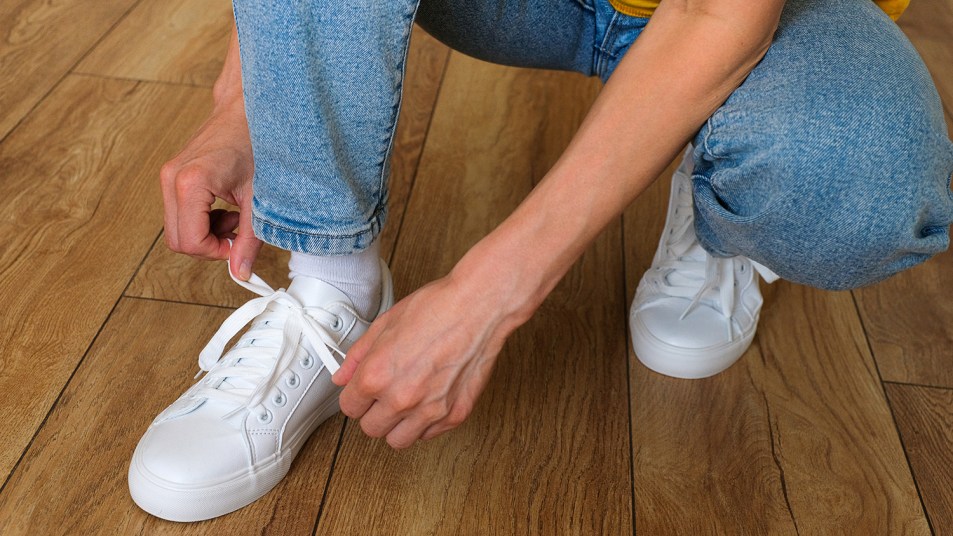This Free, Easy Exercise Lowers Blood Pressure and Boosts Heart Health

After high blood pressure and a cardiac arrhythmia led to two mini strokes, heart surgery seemed like Gayle Nichols’ only option. Then she discovered a surprising and simple path back to health: house walking!
A Medicated Life
This isn’t how I imagined my retirement, Gayle Nichols, 68, sighed sadly, leaving the hospital after having a mini stroke in March 2019 — her second in six months. The Phoenix music teacher, who was also in a band, had planned on spending her days giving music lessons part-time and performing. Instead, she had become a heart patient on multiple medications, and spent her time going to frequent doctor appointments.
I want my life back, she despaired.
A Scary Diagnosis
“My heart issues started 15 years ago, when I was in my early 50s,” says Gayle. “I suddenly started experiencing palpitations and was diagnosed with atrial fibrillation, or A-fib, an irregular and often rapid heartbeat that can lead to blood clots. I was put on 25 milligrams daily of metoprolol, a drug to regulate my heart rate.
“All was well for a long time. But then, in October of 2018, I had a mini stroke. Doctors found that my blood pressure had crept up a bit, which, combined with the A-fib, may have caused the stroke. I don’t know why, but they didn’t change or add any meds at the time. Then, six months later, my blood pressure spiked to 160/110, and I suffered a second mini stroke.
“After this terrifying episode, doctors increased my metoprolol dosage to 50 milligrams two times daily, and added Eliquis and 20 milligrams of Lipitor to prevent blood clots and strokes. It was depressing having to take so many different medicines. It felt like my bathroom was a pharmacy. And yet, as I checked my blood pressure daily, it continued to hover around 140/90 to 160/90, sometimes even a little higher, and I was still having palpitations.
“In June of 2020, things reached a new level when the doctor said I might need a procedure, called an ablation, to block abnormal electrical signals in my heart causing the palpitations. I was completely petrified.
“‘Something has to change,’ I tearfully told my husband.
An Easy RX
“I had always exercised regularly, but with the pandemic, my gym had closed and I’d become a couch potato. I figured getting off the couch would be a good first step. I had always read about walking being good for both physical and mental health, and I knew it was easy enough to do. But with the cold weather setting in, it would be hard to follow a regular walking routine outdoors.
“Then I spotted a Facebook post from a friend about an online walking group she’d joined, called 99 Walks, that had a house walking program. At first, the idea of doing walking around my small apartment, which is about 970 square feet, felt — and sounded — a
bit odd, but I didn’t have anything to lose. I signed up for a one-month membership costing $16.
“I began with one 15-minute house walking session from the app that had me start in my living room, loop into the kitchen and back out to the living room. I was shocked: It was a real workout! I even had sore muscles the next day.
“I continued with the program, and after about a month, I had increased my walk to up to at least 30 minutes and was covering more rooms of my house. Best of all, my blood pressure was steadily declining. I was so pleased that I purchased an annual membership to 99 Walks for $149.
“After a few months, I was thrilled to see my blood pressure had dropped to 112/78. I also noticed I wasn’t getting palpitations anymore. I was so excited to return to my doctor for a checkup. My doctor was shocked and pleased and told me that I no longer needed the ablation procedure. When I explained that I’m doing three house walks for 30 minutes each at least five times a week, he told me to keep up the good work!
“Walking did what all the medicine was unable to do: It got my blood pressure down into the normal, healthy range, and today, I am off my blood pressure medication! Though I have to stay on my medication for A-fib, house walking has helped me increase my balance, energy and endurance. It has also given my husband peace of mind that I will stay healthy — he’s even started house walking with me. At age 68, I am finally living the retirement of my dreams. I can now easily do a two-hour gig with my band, standing up, singing and playing bass when I perform. I feel absolutely amazing!”
How Walking Bolsters Heart Health
Walking lowers blood pressure, reduces the risk of atrial fibrillation and improves overall health, says cardiologist Nieca Goldberg, M.D., medical director at Atria New York City and a clinical associate professor at the NYU Grossman School of Medicine. “Gentle exercise relaxes blood vessels and lowers the pressure needed for the heart to deliver blood.”
Research in the journal Hypertension found that just four weeks of aerobic exercise like walking lowers systolic blood pressure (the top number) by seven points and diastolic (the bottom number) pressure by five. It also reduces the risk of more serious heart episodes, such as an irregular heart rhythm like A-fib that could lead to stroke. “Walking is healthy anywhere you do it — outdoors, on a treadmill or around your home,” adds Dr. Goldberg. Plus, strolling indoors means you won’t need to plan your walks around the elements, making getting your steps a cinch.
To get the perks, follow Gayle Nichols’ lead and walk in your home for 15 to 30 minutes a day. Try an online walking group (like 99 Walks, which Nichols used), or search “indoor walking workout” on YouTube and try a free video with Denise Austin or Leslie Sansone.
First For Women aims to feature only the best products and services. We update when possible, but deals expire and prices can change. If you buy something via one of our links, we may earn a commission. Questions? Reach us at shop@firstforwomen.com
A version of this article originally appeared in our print magazine, First for Women.













